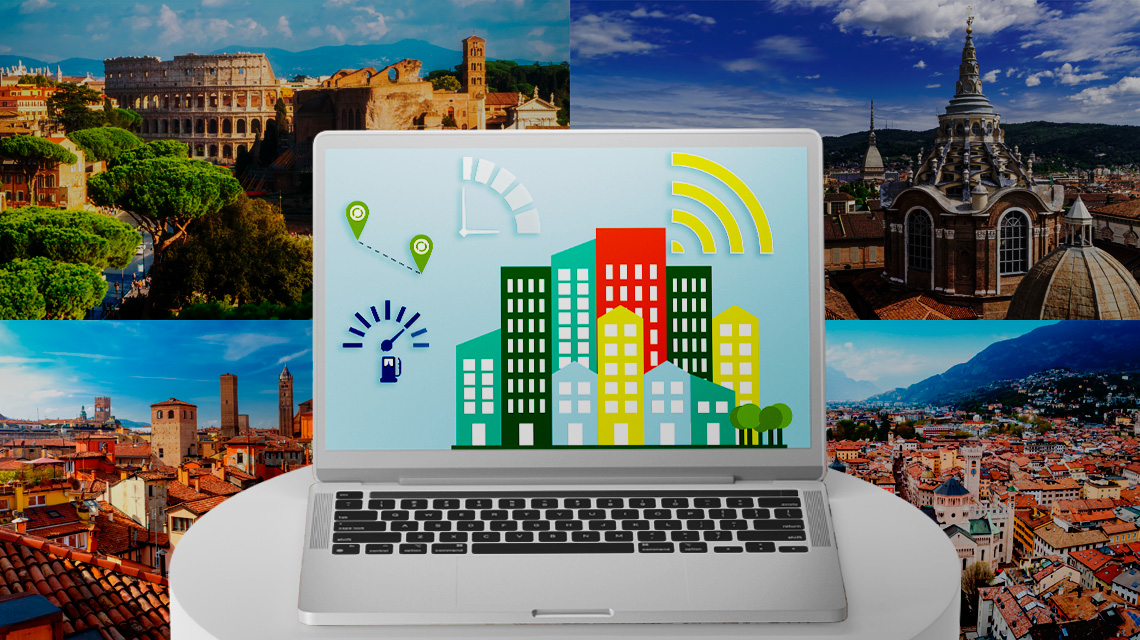Italian National Agency for New Technologies, Energy and Sustainable Economic Development

Environment: Working from home, ENEA study in four cities proves emissions reduction
Working from home reduces the emission of approximately 600 kilograms of carbon dioxide per year per worker[1] (-40%)[2] with considerable savings in time (approximately 150 hours), distance traveled (3,500 km) and fuel (260 liters of petrol or 237 liters of diesel), as shown by an ENEA study on the environmental impact of remote working in Rome, Turin, Bologna and Trento over the four-year period 2015-2018, published in the international journal Applied Sciences.
"In our country about one person in two owns a car, that is to say 666 cars per 1,000 inhabitants, which makes Italy second in Europe for motorization rate, following Luxembourg", explained Roberta Roberto, ENEA researcher at the Department of Energy Technologies and Renewable Sources and co-author of the survey, together with Bruna Felici, Alessandro Zini and Marco Rao.
In Italy, transport generates over 25% of total national greenhouse gas emissions, of which 93% from road transport, with cars accounting for the largest share (70%). “Remote working has proved to improve work-life balance, reduce traffic and urban air pollution and revitalize entire suburban areas and neighborhoods considered dormitories”, said Roberto.
Based on the responses of a sample[3] of 1,269 remote workers in the PA in the four cities examined, who use private internal combustion vehicles for commuting, a day of working from home would result in 6 kg CO2 emissions reduction and 85 megajoules (MJ) fuel saving per capita. But there are further environmental benefits: a reduction in nitrogen oxides per person per day (from 14.8 g in Trento to 7.9 g in Turin), carbon monoxide (from 38.9 g of Rome to 18.7 g of Trento) and PM10 (from 1.6 g of Rome to 0.9 g of Turin), PM2.5 (from 1.1 g of Rome and Trento to 0.6 g of Turin ). Furthermore, to travel outside work hours during remote working 24.8% of the sample chose more environmentally friendly means of transportation (public transport, walking or cycling), 8.7% opted for private transportation, 66.5% did not change their mobility habits.
"These four cities were chosen for two reasons: their territorial peculiarities and their history which suggest diversified impacts on urban mobility, and the high number of responses to the questionnaire from civil servants working from home 2 days a week on average ”, pointed out Bruna Felici, ENEA researcher at the Studies, Analyses and Evaluations Unit.
The data show that on average the sample travels 35 km a day for a duration of 1 hour and 20 minutes. Rome was confirmed as the worst city, with an average travel time of 2 hours, probably due to greater distances (1 out of 5 workers travel more than 100 km a day) and more intense traffic. In fact, in the capital there are around 420,000 daily trips for work and study purposes, while each person spends 82 hours a year in traffic.
About half of the sample travels exclusively with private means of transportation (47% by car and 2% on two wheels), while 17% travels exclusively with public transport and 16% with a mix of public/ private means. Trento has the greatest use of private internal combustion vehicles for commuting (62.9%), followed by Rome (54.4%), Bologna (44.9%) and Turin (38.2% ). “Private mobility provides time savings and freedom of movement, especially for those with school-age children. Public transport saves money and offers the solution to the scarcity of parking spaces", said Alessandro Zini, researcher at the ENEA Studies, Analyses and Evaluations Unit.
Summary table - Average indicators for people who use the car to commute, exclusively or in combination with other means, who worked remotely
|
Cities |
People working remotely (n) |
Remote working days (n) |
Vehicle distance travel avoided (km/day) |
CO2 emissions avoided (kg/day) |
Fuel saved (MJ/day) |
|---|---|---|---|---|---|
|
Bologna |
371 |
2.3 |
34.1 |
5.9 |
86.3 |
|
Roma |
281 |
2.8 |
39.2 |
6.8 |
95.0 |
|
Torino |
306 |
1.8 |
27.7 |
4.8 |
68.0 |
|
Trento |
311 |
1.7 |
40.9 |
6.5 |
90.9 |
|
Total for the 4 cities |
1269 |
2.1 |
35.4 |
6.0 |
85.0 |
Notes
[1] The values shown refer to working remotely two days a week for a total of 100 days per year
[2] Rispetto al dato IEA di emissione pro-capite per l’Italia nel 2018.
[3] L’indagine ha coinvolto un campione complessivo di 3.397 persone di 29 amministrazioni pubbliche su tutto il territorio italiano, che hanno applicato il lavoro da remoto nel periodo 2015-2018, quindi prima della pandemia. In linea con i dati demografici dei dipendenti nella pubblica amministrazione, il 73,7% del campione è costituito da donne over 50; il 52% del campione ha bambini in età scolare e il 42% dichiara di avere familiari bisognosi di assistenza. Le persone in lavoro da remoto hanno fornito, in maniera anonima, informazioni su mobilità casa-lavoro, tempi di viaggio e distanza giornaliera percorsa. L’analisi si è concentrata sulle risposte pervenute da lavoratori ‘agili’ con sede a Bologna, Torino, Trento e Roma, che utilizzano l’auto per recarsi al lavoro, in modo esclusivo o in combinazione con altri mezzi.
